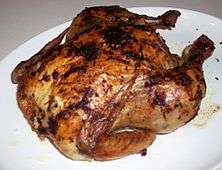White meat

White meat or light meat refers to the lighter-colored meat of poultry, as contrasted with dark meat. In a more general sense, white meat may refer to any lighter-colored meat, as contrasted with red meats like beef and some types of game.
White meat is made up of fast-twitch muscle fibres, while red, or dark, meat is made up of muscles with fibres that are slow-twitch.[1]
Pork
Given nutritional concerns, meat producers are eager to have their products considered white meat, and the United States National Pork Board has positioned their product as "Pork. The Other White Meat", alongside poultry and fish; this follows the traditional gastronomic classification. However, meats which are red when raw and turn white on cooking, like pork, are categorized by the United States Department of Agriculture as red meats if the myoglobin level is higher than 65%, and this is the definition used in nutritional studies.[2][3] This categorization is controversial as some types of fish, such as tuna, are red when raw and turn white when cooked; similarly, certain types of poultry that are sometimes grouped as "white meat" are actually red when raw, such as duck and goose. In contrast, the USDA considers all meat from mammals to be "red meat."[4]
In Israel, where Jewish dietary laws are popularly practiced, forbidding the consumption of pork, "white meat" is the accepted euphemism for pork.[5]
Poultry
Within poultry, there are two types of meats—white and dark. The different colors are based on the different locations and uses of the muscles. For ground-based birds like chicken and turkeys, dark meats occur in the legs, which are used to support the weight of the animals while they move. These muscles are designed to develop endurance for long-term use and contain a large amount of myoglobin, allowing the muscle to use oxygen more efficiently for aerobic respiration. In contrast the white meat, generally found within the breasts of the birds, are used for quick bursts of power which requires little of the meat-darkening myoglobin. Birds which use their chest muscles for sustained flight (such as geese and ducks) have dark meat throughout their bodies.[6]
Dark meat contains 2.64 times more saturated fat than white meat, per gram of protein.[7] One commentator wrote that dark meat contains more vitamins,[8] while a New York Times columnist has stated the two meats are nearly identical in nutritional value, especially when compared with typical red meat. According to the U.S. Department of Agriculture, one ounce of boneless, skinless turkey breast contains about one gram of fat, compared with roughly two grams of fat for an ounce of boneless, skinless thigh.[9] The numbers go up when the skin is kept in: a chicken thigh, with skin intact, has 13 grams of total fat and 3 1/2 grams of saturated fat per 3-ounce serving; this is about 20 percent of the recommended maximum daily intake.[10]
References
- ↑ "Archived copy". Archived from the original on 2016-03-12. Retrieved 2014-08-18.
- ↑ Lee, Elizabeth. "The Truth About Red Meat". Web MD. Retrieved 12 October 2014.
- ↑ National Agricultural Statistics Service (2005-11-03). "Idaho Red Meat Production Down 40 Percent" (PDF). United States Department of Agriculture. Retrieved 2007-04-05.
- ↑ "USDA-Safety of Fresh Pork...from Farm to Table". Fsis.usda.gov. 2008-05-16. Retrieved 2009-09-16.
- ↑ "Mexican Flu: The Other White Meat : On Language". The Jewish Daily Forward. 6 May 2009. Retrieved 14 September 2009.
- ↑ Article on the color of turkey and chicken meat Archived January 27, 2007, at the Wayback Machine.
- ↑ "Dark Meat Versus White Meat: What's The Difference". Retrieved 2012-02-20.
- ↑ "Come To The Dark Side Of The Chicken; It's Tastier". Retrieved 2011-02-26.
- ↑ Anahead O'Connor, "Really? The Claim: White Meat Is Healthier Than Dark Meat" Archived April 6, 2016, at the Wayback Machine. in the New York Times," 20 Nov 2007.
- ↑ "The Nutrition of Chicken Breasts Vs. Thighs". healthyeating.sfgate.com. Retrieved 22 June 2016.

